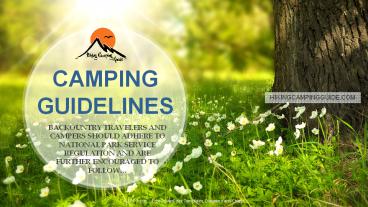The Ultimate Camping Guide - PowerPoint PPT Presentation
Title:
The Ultimate Camping Guide
Description:
Use this camping guide to help you get the most out of your next trip in the woods. Camping is a great way to experience the beauty of nature and escape the hustle and bustle of our busy world. – PowerPoint PPT presentation
Number of Views:101
Title: The Ultimate Camping Guide
1
CAMPING GUIDELINES
HIKINGCAMPINGGUIDE.COM
BACKOUNTRY TRAVELERS AND CAMPERS SHOULD ADHERE TO
NATIONAL PARK SERVICE REGULATION AND ARE FURTHER
ENCOURAGED TO FOLLOW
ALLPPT.com _ Free PowerPoint Templates, Diagrams
and Charts
2
CAMPING Guidelines
Backcountry travelers and campers should adhere
to National Park Service regulations and are
further encouraged to follow Guidelines to
minimize their impact on the fragile desert
environment.
While pets are welcome as travel and camping
companions in Mojave National Preserve, they
must be leashed and never left unattended
(including inside vehicles). Pet excrement must
be collected and disposed of in garbage
receptacles.
3
1. Plan Ahead and Prepare
There is no permit or registration system for
backcountry travel camping at Mojave National
Preserve be sure to notify others of your travel
itinerary.
Few established trails exist carry a good map
and familiarize yourself with desert travel and
survival skills before beginning your trip.
4
2. Travel and Camp on Durable Surfaces
There is no permit or registration system for
backcountry travel camping at Mojave National
Preserve be sure to notify others of your travel
itinerary.
Reuse existing campsites
Do not make camp in a dry washflash floods
develop quickly in the desert.
Camping is limited to a maximum of 14
consecutive days per visit/stay and 30 total days
per year.
Campsites must be more than 200 yards from any
water source.
Camping is not permitted within 1/4 mile of
any paved road or the Zzyzx Road within 1/2 mile
of Fort Piute or Kelso Depot within 1 mile north
(i.e., the crest of the dunes) or 1/4 mile south
of the Kelso Dunes access road.
5
3. Dispose of Waste Properly
Store all food and garbage in a manner that will
prevent access by wildlife. Carry plastic bags
and pack out all trash.
Bury human waste in catholes 6-8 inches deep, at
least 200 feet from water, camp, and trails.
Don't bury toilet paper or hygiene products -
carry a plastic bag and pack it out.
Pet excrement must be collected and disposed of
in garbage receptacles.
6
4. Leave What You Find
Disturbing, defacing, or collecting plants,
animals, rocks, and historic or archeological
objects is prohibited. As part of our national
heritage, these resources should be left as they
are found for all to enjoy. Metal detectors are
not allowed.
7
5. Minimize Campfire Impacts
Campfires are allowed in established fire rings
only, or with use of a portable firepan (be sure
to pack out ashes). Do not leave fires smoldering
or unattended.
Cutting or collecting any wood, including downed
wood, is prohibited. All firewood must be
brought into the preserve.
8
6. Respect Wildlife
9
7. Be Considerate of Other Visitors


















![⚡Read✔[PDF] How To Poop Upside Down: A survival guide to pooping on the go PowerPoint PPT Presentation](https://s3.amazonaws.com/images.powershow.com/10087151.th0.jpg?_=20240727032)












